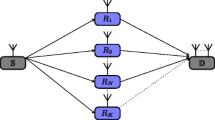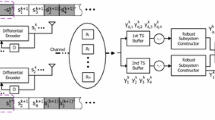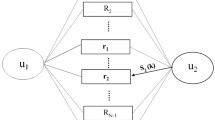Abstract
Deployment of Space-Time Block Code (STBC) over wireless relaying communication networks has been identified as one of the most promising techniques because of its potential to support high-performance and high data-rate for wireless communication technologies of the future. It is called Distributed-STBC (D-STBC) as it uses clients’ nodes as relaying nodes to form a virtual Multiple-Input Multiple-Output (MIMO) channel. However, this requires perfect synchronization among the relaying nodes. Unfortunately, as this is impossible to achieve in real world networks, the structure of the code matrix is compromised causing the channel to appear dispersive. This paper firstly derives a general model of D-STBC systems which will then be used to show the effects of imperfect synchronization on such schemes. Then, it highlights the majority of the schemes used to mitigate the performance degradation due to the asynchronism. In addition, it suggests some schemes that could be considered when conditions of imperfect synchronization exist.







Similar content being viewed by others
References
Molisch, A. F. (2010). Wireless communications (2nd ed.). New Jersey: Wiley.
Foschini, G. J. (1996). Layered space-time architecture for wireless communication in a fading environment when using multi-element antennas. Bell Labs Technical Journal, 1(2), 41–59.
Telatar, E. (1999). Capacity of multi-antenna gaussian channels. European Transactions on Telecommunications, 10(6), 585–595.
Oestges, C., & Clerckx, B. (2007). MIMO wireless communications: From real-world propagation to space-time code design (1st ed.). Massachusetts: Academic Press.
Alamouti, S. M. (1998). A simple transmit diversity technique for wireless communications. IEEE Journal on Selected Areas in Communications, 16(8), 1451–1458.
Liu, K. J. R. (2009). Cooperative communications and networking. Cambridge: Cambridge University Press.
Laneman, J. N., & Wornell, G. W. (2003). Distributed space-time-coded protocols for exploiting cooperative diversity in wireless networks. IEEE Transactions on Information Theory, 49(10), 2415–2425.
Jing, Y., & Hassibi, B. (2006). Distributed space-time coding in wireless relay networks. IEEE Transactions on Wireless Communications, 5(12), 3524–3536.
Jing, Y., & Jafarkhani, H. (2007). Using orthogonal and quasi-orthogonal designs in wireless relay networks. IEEE Transactions on Information Theory, 53(11), 4106–4118.
Yiu, S., Schober, R., & Lampe, L. (2006). Distributed space-time block coding. IEEE Transactions on Communications, 54(7), 1195–1206.
Wei, S., Goeckel, D. L., & Valenti, M. C. (2006). Asynchronous cooperative diversity. IEEE Transactions on Wireless Communications, 5(6), 1547–1556.
Zheng, F., Burr, A. G., & Olafsson, S. (2009). Signal detection for distributed space-time block coding: 4 relay nodes under quasi-synchronisation. IEEE Transactions on Communications, 57(5), 1250–1255.
Jia, Y., Andrieu, C., Piechocki, R. J., & Sandell, M. (2005). Gaussian approximation based mixture reduction for near optimum detection in MIMO systems. IEEE Communications Letters, 9(11), 997–999.
Nguyen, T., Berder, O., & Sentieys, O. (2008). Impact of transmission synchronization error and cooperative reception techniques on the performance of cooperative MIMO systems. In IEEE international conference on communications, pp. 4601–4605.
Sendonaris, A., Erkip, E., & Aazhang, B. (2003). User cooperation diversity—part i: System description. IEEE Transactions on Communications, 51(11), 1927–1938.
Sendonaris, A., Erkip, E., & Aazhang, B. (2003). User cooperation diversity—part ii: Implementation aspects and performance analysis. IEEE Transactions on Communications, 51(11), 1939–1948.
Maadi, S., & Hamdi, N. (2011). Joint power allocation and beamforming for cooperative networks. International Journal of Communications, Network and System Sciences, 4(7), 447–451.
Xu, L., & Zhang, H. (2011). Optimum relay location in cooperative communication networks with single af relay. International Journal of Communications, Network and System Sciences, 4(3), 147–151.
Zhang, C., Zhang, J., Wang, W., & Wei, G. (2009). Distributed space-time decoding with two-pilot channel estimation for wireless relay networks. In IEEE international symposium on personal. Indoor and mobile radio communications, PIMRC.
Gao, F., Cui, T., & Nallanathan, A. (2008). On channel estimation and optimal training design for amplify and forward relay networks. IEEE Transactions on Wireless Communications, 7(5), 1907–1916.
Wu, Y., & Patzold, M. (2009). Parameter optimization for amplify-and-forward relaying systems with pilot symbol assisted modulation scheme. Wireless Sensor Network, 1(1), 15–21.
Laneman, J. N., Tse, D. N. C., & Wornell, G. W. (2004). Cooperative diversity in wireless networks: Efficient protocols and outage behavior. IEEE Transactions on Information Theory, 50(12), 3062–3080.
Vucetic, B. (2003). Space-time block codes (1st ed.). New Jersey: Wiley.
El Astal, M.-T. O., & Abu-Hudrouss, A. M. (2011). Sic detector for 4 relay distributed space-time block coding under quasi-synchronization. IEEE Communications Letters, 15(10), 1056–1058.
Zheng, F., Burr, A. G., & Olafsson, S. (2008). Near-optimum detection for distributed space-time block coding under imperfect synchronization. IEEE Transactions on Communications, 56(11), 1795–1799.
Zheng, F.-C., Burr, A. G., & Olafsson, S. (2007). Distributed space-time block coding for 3 and 4 relay nodes: Imperfect synchronisation and a solution. In IEEE international symposium on personal, indoor and mobile radio communications, PIMRC, pp. 1596–1601.
Elazreg, A. M., Mannai, U. N., & Chambers, J. A. (2010). Distributed cooperative space-time coding with parallel interference cancellation for asynchronous wireless relay networks. In SoftCOM 2010—International conference on software, telecommunications and computer networks, pp. 360–364.
El Astal, M. T. O., & Olivier, J. C. (2013). Distributed closed-loop extended orthogonal STBC: Improved performance in imperfect synchronization. In IEEE international symposium on personal, indoor and mobile radio communications, PIMRC, pp. 1941–1945.
Elazreg, A. M., & Chambers, J. A. (2009). Closed-loop extended orthogonal space time block coding for four relay nodes under imperfect synchronization. In IEEE workshop on statistical signal processing proceedings, pp. 545–548.
Yu, Y., Keroueden, S., & Yuan, J. (2006). Closed-loop extended orthogonal space-time block codes for three and four transmit antennas. IEEE Signal Processing Letters, 13(5), 273–276.
Elazreg, A. M., Abdurahman, F. M., & Chambers, J. A. (2009) Distributed closed-loop quasi-orthogonal space time block coding with four relay nodes: Overcoming imperfect synchronization. In WiMob 2009—5th IEEE international conference on wireless and mobile computing networking and communication, pp. 320–325.
Toker, C., Lambotharan, S., & Chambers, J. A. (2004). Closed-loop quasi-orthogonal STBCs and their performance in multipath fading environments and when combined with turbo codes. IEEE Transactions on Wireless Communications, 3(6), 1890–1896.
Wang, X., & Wu, Z. (2009). Interference cancellation technique under imperfect synchronization in cellular systems. Journal of Shanghai University, 13(5), 379–383.
Xin, W., & Zhuo, W. (2009). Pic detector for joint distributed STBC under imperfect synchronization. In Proceedings—5th international conference on wireless communications, networking and mobile computing: WiCOM 2009.
Xu, J., Choi, J. Y., & Seo, J. (2008). Distributed space-time coding and equalization for cooperative cellular communication system. IEEE Transactions on Consumer Electronics, 54(1), 47–51.
Zheng, F., Burr, A. G., & Olafsson, S. (2007). A simple optimum detector for distributed space-time block coding under imperfect synchronisation. In IEEE workshop on signal processing advances in wireless communications, SPAWC.
Zheng, F., Burr, A. G., & Olafsson, S. (2007). Pic detector for distributed space-time block coding under imperfect synchronisation. Electronics Letters, 43(10), 580–582.
El Astal, M.-T., & Abu-Hudrouss, A. M. (2012). Generalized pic detector for distributed STBC under quasi-synchronization. Wireless Engineering and Technology, 3(1), 25–29.
Su, W., & Xia, X. (2004). Systematic design of complex orthogonal space-time block codes with high rates. 2004 IEEE Wireless Communications and Networking Conference, WCNC 2004, 2004(3), 1442–1445.
Zheng, F., Burr, A. G., & Olafsson, S. (2007). Distributed space-time block coding with incremental relay: Performance improvement under imperfect synchronisation. In 2007 16th IST mobile and wireless communications summit.
Cui, T., Gao, F., Ho, T., & Nallanathan, A. (2009). Distributed space-time coding for two-way wireless relay networks. IEEE Transactions on Signal Processing, 57(2), 658–671.
Mannai, U. N., Abdurahman, F. M., Elazreg, A. M., & Chambers, J. A. (2011). Orthogonal space time block coding for two-way wireless relay networks under imperfect synchronization. In IWCMC 2011—7th international wireless communications and mobile computing conference, pp. 1694–1697.
El Astal, M. O., & Olivier, J. C. (2012). Distributed orthogonal STBC for amplify and forward cooperative network under imperfect synchronization. In International conference on communication technology proceedings, ICCT, pp. 364–368.
El Astal, M.-T., Salmon, B. P., & Olivier, J. C. (2014). Distributed space-time block coding for two-way wireless relaying networks: Improved performance under imperfect synchronization. Accepted for publication in IEEE WCNC 2014.
Bolcskei, H. (2006). MIMO-OFDM wireless systems: Basics, perspectives, and challenges. IEEE Wireless Communications, 13(4), 31–37.
Esmaiel, H., & Danchi, J. (2013). Image transmission over underwater acoustic environment using OFDM technique with hqam mapper. In Information science and technology (ICIST), 2013 international conference on, pp. 1596–1601.
Logothetis, A., Osseiran, A., & Slimane, S. (2008). Distributed relay diversity systems for OFDM-based networks. International Journal of Communications, Network and System Sciences, 1(3), 215–227.
Shin, O., Chan, A. M., Kung, H. T., & Tarokh, V. (2007). Design of an OFDM cooperative space-time diversity system. IEEE Transactions on Vehicular Technology, 56(4 II), 2203–2215.
Alotaibi, F. T., & Chambers, J. A. (2010). Full-rate and full-diversity extended orthogonal space-time block coding in cooperative relay networks with imperfect synchronization. In ICASSP, IEEE international conference on acoustics, speech and signal processing—Proceedings, pp. 2882–2885.
Alotaibi, F. T., Abdurahman, F., Mannai, U., & Chambers, J. A. (2011). Extended orthogonal space-time block coding scheme in asynchronous two-way cooperative relay networks over frequency-selective fading channels. In 17th DSP 2011 international conference on digital signal processing, proceedings.
Ng, F., & Li, X. (2005). Cooperative STBC-OFDM transmissions with imperfect synchronization in time and frequency. Conference Record - Asilomar Conference on Signals, Systems and Computers, 2005, 524–528.
Manna, M. A., Qaja, W. M., & Chambers, J. A. (2013) Ofdm-based modified quasi-orthogonal space-time scheme for use in asynchronous cooperative networks with relay selection. In 2013 20th international conference on telecommunications, ICT 2013.
Ma, Y., Jiang, H., & Du, S. (2014). Two-way cyclotomic orthogonal space-time transmission scheme for asynchronous cooperative systems. In 2014 international conference on computing, networking and communications, ICNC 2014, pp. 686–690.
Damen, M. O., & Hammons, A. R, Jr. (2007). Delay-tolerant distributed-tast codes for cooperative diversity. IEEE Transactions on Information Theory, 53(10), 3755–3773.
El Gamal, H., & Damen, M. O. (2003). Universal space-time coding. IEEE Transactions on Information Theory, 49(5), 1097–1119.
Wu, N., & Gharavi, H. (2010). Asynchronous cooperative mimo systems using a linear dispersion structure. IEEE Transactions on Vehicular Technology, 59(2), 779–787.
Bhatnagar, M. R., HjÞrungnes, A., & Debbah, M. (2010). Delay-tolerant decode-and-forward based cooperative communication over ricean channels. IEEE Transactions on Wireless Communications, 9(4), 1277–1282.
Torbatian, M., & Damen, M. O. (2009). On the design of delay-tolerant distributed space-time codes with minimum length. IEEE Transactions on Wireless Communications, 8(2), 931–939.
Wang, W., Zheng, F., Burr, A., & Fitch, M. (2012). Design of delay-tolerant linear dispersion codes. IEEE Transactions on Communications, 60(9), 2560–2570.
Sarkiss, M., Othman, G. R., Damen, M. O., & Belfiore, J. (2011). Construction of new delay-tolerant space-time codes. IEEE Transactions on Information Theory, 57(6), 3567–3581.
Liu, Y., Zhang, W., & Ching, P. C. (2013). Full-diversity distributed space-time codes with an efficient ml decoder for asynchronous cooperative communications. In ICASSP, IEEE international conference on acoustics, speech and signal processing—proceedings, pp. 5011–5015.
Liu, Y., Zhang, W., Liew, S. C., & Ching, P. (2014). Bounded delay-tolerant space-time codes for distributed antenna systems. IEEE Transactions on Wireless Communications, 13(8), 4644–4655.
Li, X. (2004). Space-time coded multi-transmission among distributed transmitters without perfect synchronization. IEEE Signal Processing Letters, 11(12), 948–951.
Yadav, A., Juntti, M., & Karjalainen, J. (2009) Combating timing asynchronism in relay transmission for 3gpp lte uplink. In IEEE wireless communications and networking conference, WCNC.
Hwang, T., & Li, Y. (2003). Iterative cyclic prefix reconstruction for coded single-carrier systems with frequency-domain equalization(sc-fde). IEEE Vehicular Technology Conference, 57, 1841–1845.
Gao, Z., Liao, X., Sun, X., & Zhu, S. (2013) A secure space-time code for asynchronous cooperative communication systems with untrusted relays. In IEEE wireless communications and networking conference, WCNC, pp. 4192–4196.
Author information
Authors and Affiliations
Corresponding author
Rights and permissions
About this article
Cite this article
EL Astal, MT., Abu-Hudrouss, A.M. & Olivier, J.C. Improved Signal Detection of Wireless Relaying Networks Employing Space-Time Block Codes Under Imperfect Synchronization. Wireless Pers Commun 82, 533–550 (2015). https://doi.org/10.1007/s11277-014-2239-4
Published:
Issue Date:
DOI: https://doi.org/10.1007/s11277-014-2239-4




